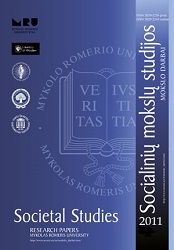Item Response Theory Applications for Social Phenomena Modeling
Item Response Theory Applications for Social Phenomena Modeling
Author(s): Aleksandras Krylovas, Natalja KosarevaSubject(s): History and theory of sociology, Methodology and research technology, Crowd Psychology: Mass phenomena and political interactions, Human Ecology
Published by: Mykolas Romeris University
Keywords: Item Response Theory; mathematical modeling; test information function; Environmental Performance Index; latent feature; norms-referenced evaluation;
Summary/Abstract: The article reviews Item Response Theory facilities in modeling social phenomena, its advantages and disadvantages comparing with Classical Test Theory and mathematical statistics methods. It discusses the application of IRT in social sciences specifics. The extension of Item Response Theory model where item characteristic functions have been approximated not only with logistic functions, but also with functions from other wide classes of parametric functions is presented. The procedure of item calibration—choosing of the best fitting item characteristic function and parameter’s estimation—is described in the paper. When choosing the item characteristic function for the model from wider class of functions as the result we obtain better agreement between observed data and the formal model. The example of IRT application in measuring the Environmental Performance Index is examined. The technology of extending the class of logistic functions used for simulation was applied in this case study. Calculated test information function’s values for the proposed mixed model were higher comparing with corresponding values for 2 parameters logistic model. The clusterization procedure performed by EPI values calculated as the total score of 9 items test was accomplished. Kendall‘s τ and Spearman’s ρ rank correlation coefficients for measuring the relation between estimations of EPI accomplished by the total test score value and the EPI value calculated as the weighted sum of 25 indicators are presented for different values of test items n. It was shown that the new methodology allows to perform rather precise norms-referenced evaluation of objects with respect to latent feature which couldn’t be measured directly with a significantly less amount information. The proposed methodology could be used in various areas of human activities where the actual problem is norms-referenced evaluation.
Journal: Socialinių mokslų studijos
- Issue Year: 3/2011
- Issue No: 1
- Page Range: 77-93
- Page Count: 17
- Language: English

